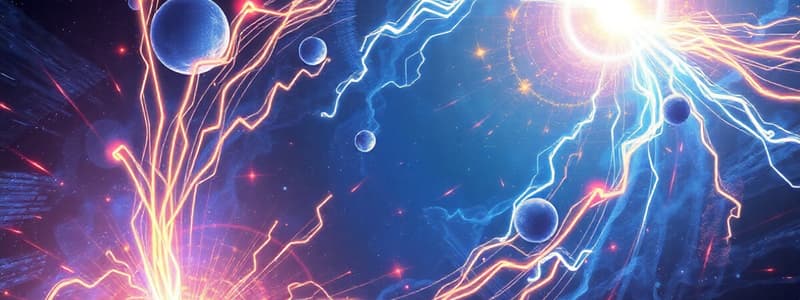Podcast
Questions and Answers
Which force is responsible for holding protons and neutrons together in the nucleus?
Which force is responsible for holding protons and neutrons together in the nucleus?
- Gravitational Force
- Strong Nuclear Force (correct)
- Electromagnetic Force
- Weak Nuclear Force
What does Newton's second law state?
What does Newton's second law state?
- For every action, there is an equal and opposite reaction.
- Force equals mass times acceleration. (correct)
- Energy cannot be created or destroyed.
- An object at rest stays at rest.
Which heat transfer method occurs through direct contact?
Which heat transfer method occurs through direct contact?
- Radiation
- Insulation
- Conduction (correct)
- Convection
What is represented by the equation v = u + at?
What is represented by the equation v = u + at?
Which law states that entropy in an isolated system always increases?
Which law states that entropy in an isolated system always increases?
What does Ohm's law relate?
What does Ohm's law relate?
Which of the following describes wave-particle duality?
Which of the following describes wave-particle duality?
What is a characteristic of simple harmonic motion?
What is a characteristic of simple harmonic motion?
Flashcards are hidden until you start studying
Study Notes
Key Concepts in Physics
Fundamental Forces
-
Gravitational Force:
- Attraction between masses.
- Governed by Newton's law of universal gravitation.
-
Electromagnetic Force:
- Interactions between charged particles.
- Described by Coulomb's law and Maxwell's equations.
-
Weak Nuclear Force:
- Responsible for radioactive decay.
- Plays a key role in nuclear reactions.
-
Strong Nuclear Force:
- Holds protons and neutrons together in the nucleus.
- Operates at short ranges.
Classical Mechanics
-
Newton’s Laws of Motion:
- An object at rest stays at rest; an object in motion stays in motion unless acted upon by a force.
- F = ma (Force equals mass times acceleration).
- For every action, there is an equal and opposite reaction.
-
Work, Energy, and Power:
- Work = force x distance (in the direction of the force).
- Kinetic Energy = 1/2 mv²; Potential Energy = mgh.
- Power = work done/time.
Thermodynamics
-
Laws of Thermodynamics:
- Energy cannot be created or destroyed, only transformed.
- Entropy of an isolated system always increases.
- Absolute zero cannot be reached; systems approach it asymptotically.
-
Heat Transfer:
- Conduction: Heat transfer through direct contact.
- Convection: Heat transfer through fluid movement.
- Radiation: Heat transfer through electromagnetic waves.
Waves and Oscillations
-
Wave Properties:
- Wavelength, frequency, amplitude, speed.
- Types: Transverse (e.g., light) and longitudinal (e.g., sound).
-
Simple Harmonic Motion:
- Motion where the restoring force is proportional to displacement.
- Described by equations of sine or cosine functions.
Electricity and Magnetism
-
Ohm's Law:
- V = IR (Voltage = Current x Resistance).
-
Circuit Elements:
- Resistors, capacitors, inductors.
- Series vs. parallel circuits.
-
Magnetic Fields:
- Created by moving charges.
- Governed by the right-hand rule.
Modern Physics
-
Quantum Mechanics:
- Behavior of particles at atomic and subatomic levels.
- Concepts of wave-particle duality and uncertainty principle.
-
Relativity:
- Special Relativity: Time dilation and length contraction at high speeds.
- General Relativity: Gravitational effects on the curvature of spacetime.
Key Equations
-
Kinematics:
- ( v = u + at )
- ( s = ut + \frac{1}{2}at^2 )
-
Momentum:
- ( p = mv ) (momentum = mass x velocity).
-
Energy Conservation:
- Total energy remains constant in an isolated system.
Applications of Physics
- Engineering: Design of structures, machines, and systems.
- Medicine: Imaging technologies (e.g., MRI, X-rays).
- Technology: Development of electronics, renewable energy sources.
These notes encompass fundamental principles and concepts foundational to the study of physics, suitable for review and study.
Fundamental Forces
- Gravitational Force: Attraction occurs between masses, described by Newton's law of universal gravitation.
- Electromagnetic Force: Interaction between charged particles, explained by Coulomb's law and Maxwell's equations.
- Weak Nuclear Force: Causes radioactive decay, crucial for various nuclear processes.
- Strong Nuclear Force: Binds protons and neutrons in the atomic nucleus, effective only at very short distances.
Classical Mechanics
- Newton’s Laws of Motion:
- An object remains at rest or in uniform motion unless acted on by a force.
- Force equals mass times acceleration (F = ma).
- For every action, there is an equal and opposite reaction.
- Work, Energy, and Power:
- Work is calculated as the product of force and distance in the direction of the force.
- Kinetic energy formula: ( KE = \frac{1}{2} mv^2 ); potential energy: ( PE = mgh ).
- Power is the rate of work done over time.
Thermodynamics
- Laws of Thermodynamics:
- Energy cannot be created or destroyed, only converted from one form to another.
- The entropy of an isolated system always increases over time.
- Absolute zero, the theoretical point at which molecular motion stops, cannot be achieved.
- Heat Transfer:
- Conduction: Transfer of heat through direct contact between materials.
- Convection: Heat transfer through the movement of fluids.
- Radiation: Transfer of heat via electromagnetic waves.
Waves and Oscillations
- Wave Properties: Includes wavelength, frequency, amplitude, and speed; categorized into transverse (e.g., light) and longitudinal waves (e.g., sound).
- Simple Harmonic Motion: A type of periodic motion where the restoring force is linearly proportional to the displacement from equilibrium; mathematically modeled with sine or cosine functions.
Electricity and Magnetism
- Ohm's Law: Defines the relationship between voltage (V), current (I), and resistance (R) as ( V = IR ).
- Circuit Elements: Key components include resistors, capacitors, and inductors; circuits can be arranged in series or parallel configurations.
- Magnetic Fields: Produced by moving electric charges, direction determined by the right-hand rule.
Modern Physics
- Quantum Mechanics: Describes the behavior of matter and energy at atomic and subatomic levels, introducing concepts of wave-particle duality and the uncertainty principle.
- Relativity:
- Special Relativity: Introduces phenomena such as time dilation and length contraction when objects move at significant fractions of the speed of light.
- General Relativity: Explains gravitation as the curvature of spacetime caused by mass.
Key Equations
- Kinematics:
- ( v = u + at ) (final velocity equals initial velocity plus acceleration times time).
- ( s = ut + \frac{1}{2}at^2 ) (displacement formula).
- Momentum: ( p = mv ) (momentum expressed as mass times velocity).
- Energy Conservation: Total energy in an isolated system remains constant despite transformations.
Applications of Physics
- Engineering: Involves the design and analysis of structures, machines, and technological systems.
- Medicine: Utilizes physics principles in imaging techniques like MRI and X-rays for diagnostics.
- Technology: Drives advancements in electronics and sustainable energy developments, adapting physical theories to practical solutions.
Studying That Suits You
Use AI to generate personalized quizzes and flashcards to suit your learning preferences.




